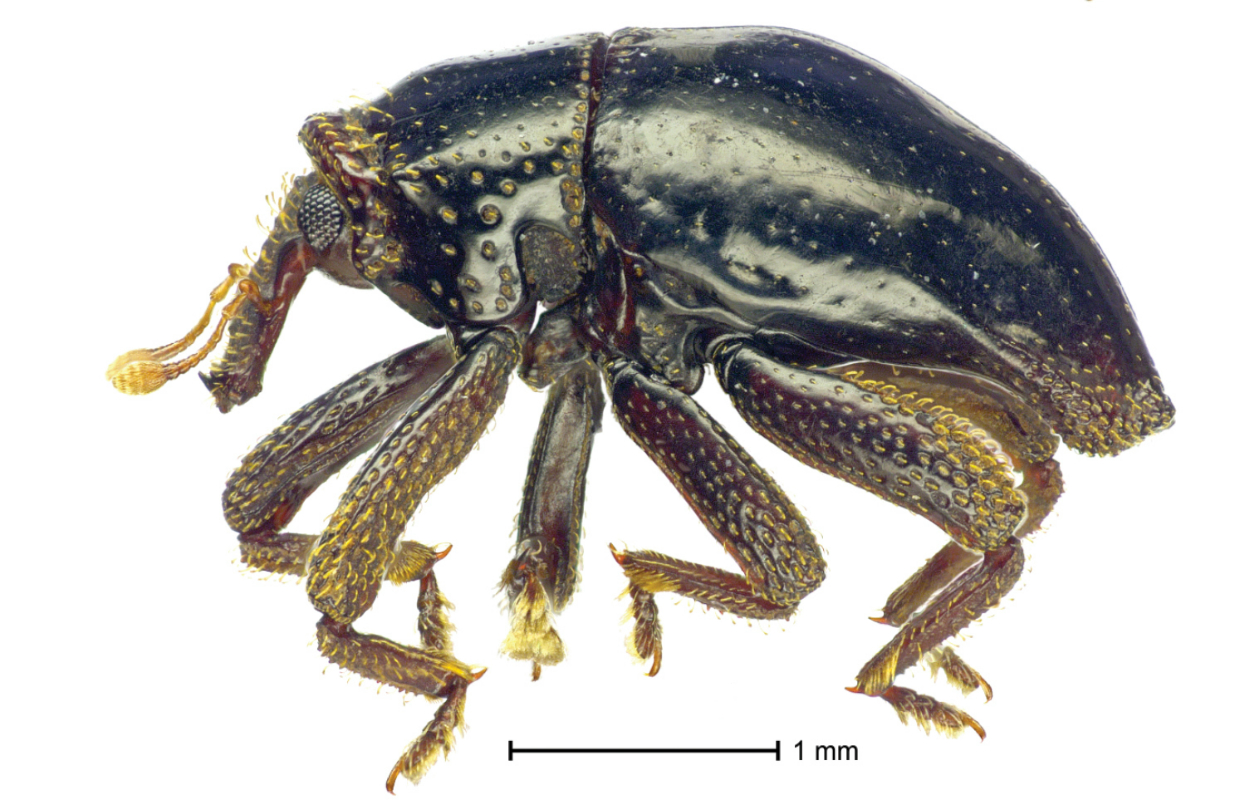Hairy-Legged 'Chewbacca Beetle' Discovered in New Guinea

The towering and shaggy Wookiee character Chewbacca from the "Star Wars" movies has a new namesake — a tiny weevil recently discovered in New Guinea.
Though the insect is significantly smaller and much less hairy than everyone's favorite "walking carpet," dense scales on the weevil's legs and head reminded the scientists of Chewbacca's fur, prompting their name choice.
Trigonopterus chewbacca is one of four new weevil species identified on the island of New Britain in the Bismarck Archipelago in New Guinea. Discovered alongside it were the somewhat less whimsically named weevils T. obsidianus, T. puncticollis and T. silaliensis. [7 Animals with 'Star Wars'-Inspired Names]
T. chewbacca is a flightless weevil, a type of beetle typically found in leaf litter in forests. The male's body is black with hair-like structures on its antennae and legs, and measures 0.13 inches (3.34 millimeters) in length.
Scientists spent 10 days combing through leaf litter in unrelenting downpours to find the miniscule beetles, eventually collecting 18 specimens that represented the four new species.
Previously, only one known species in the Trigonopterus weevil group had been found in this region, although prior studies described Trigonopterus weevils in New Caledonia, Samoa and Fiji. While T. chewbacca was the first species in this group that was named for a "Star Wars" character, it's not the only one with a celebrity-inspired moniker. Trigonopterus attenboroughi — described in a study published in ZooKeys in 2014 — was named for famed British naturalist Sir David Attenborough.
This isn't the first time that scientists who were also "Star Wars" fans incorporated their fondness for the Millennium Falcon co-pilot into a species name. A fuzzy Mexican moth was described as Wockia chewbacca in the journal Proceedings of the Entomological Society of Washington in 2009, and a wasp described as Polemistus chewbacca appeared in the journal Zoological Record in 1983.
Sign up for the Live Science daily newsletter now
Get the world’s most fascinating discoveries delivered straight to your inbox.
Other "Star Wars" characters have also inspired scientists to tap those characters' names for new species discoveries, giving us an acorn worm named after Yoda (Yoda purpurata), a trilobite named for Han Solo (Han solo) and a slime mold beetle named for Darth Vader (Agathidium vaderi).
Even a fairly minor (but still well-known) character named Greedo, the ill-fated bounty hunter killed by Han Solo in "A New Hope," is commemorated with a species name — Peckoltia greedoi, a flat-headed catfish that bears a striking resemblance to the peculiar-looking alien.
Study lead author Matthew Van Dam, a postdoctoral researcher with the Zoological State Museum in Bavaria Germany, told Live Science in an email that studying weevils — one of the planet's most diverse groups of insects — can help scientists better understand the environments that weevils occupy, and can inform future conservation efforts in threatened areas.
This could be especially critical in parts of the world where the extent of animal diversity is still unknown. Scientists reported in the new study that there could be many more animal species on the island of New Britain that haven't yet been discovered, but that time would be of the essence to track them down and identify them, as palm oil plantation expansion has already claimed significant portions of land that were once covered by forest habitats.
The findings were published online April 21 in the journal ZooKeys.
Follow Mindy Weisberger on Twitterand Google+. Follow us @livescience, Facebook & Google+. Original article on Live Science.

Mindy Weisberger is an editor at Scholastic and a former Live Science channel editor and senior writer. She has reported on general science, covering climate change, paleontology, biology and space. Mindy studied film at Columbia University; prior to Live Science she produced, wrote and directed media for the American Museum of Natural History in New York City. Her videos about dinosaurs, astrophysics, biodiversity and evolution appear in museums and science centers worldwide, earning awards such as the CINE Golden Eagle and the Communicator Award of Excellence. Her writing has also appeared in Scientific American, The Washington Post and How It Works Magazine. Her book "Rise of the Zombie Bugs: The Surprising Science of Parasitic Mind Control" will be published in spring 2025 by Johns Hopkins University Press.










